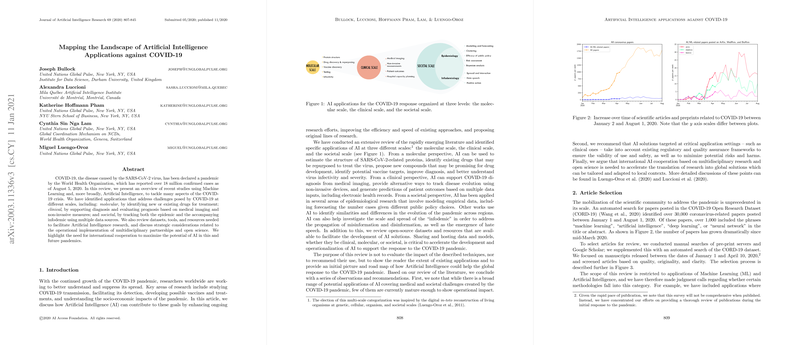The Landscape of AI Applications Against COVID-19
The research paper, “Mapping the Landscape of Artificial Intelligence Applications Against COVID-19,” provides a comprehensive review of the various applications of AI in addressing different scales of challenges posed by the COVID-19 pandemic. This meticulous synthesis highlights the potential of AI technology across molecular, clinical, and societal levels, while addressing operational and strategic considerations for its implementation.
Overview
COVID-19, caused by the SARS-CoV-2 virus, prompted an urgent demand for scalable and efficient solutions, driven in part by AI technologies. The authors systematically explore AI applications across three primary scales: molecular, clinical, and societal.
Molecular Scale
At the molecular level, AI has been pivotal in accelerating the drug repurposing and discovery process. Researchers deploy machine learning models to predict protein structures, assess protein-ligand binding affinities, and facilitate molecular docking. These methodologies expedite the identification of potential therapeutics, leveraging databases like PDBbind and DrugBank, with notable efforts from those employing Generative Autoencoders and Deep Neural Networks (DNNs).
AI is also evolving in vaccine discovery, with models identifying immunogenic epitopes on SARS-CoV-2 proteins. Neural networks such as NetMHCPan4 evaluate MHC antigen presentation, aiding in candidate vaccine development. Additionally, AI enhances nucleic acid testing through CRISPR-based methods, reducing false positives and improving SARS-CoV-2 detection accuracy.
Clinical Scale
Clinically, AI is primarily enhancing diagnostic capacities through imaging analysis. Deep learning models analyze CT and X-ray scans to distinguish COVID-19 cases from other types of pneumonia. Yet, these methods must advance in clinical evaluation and integration to exhibit real-world applicability and adhere to medical standards.
AI also contributes to non-invasive disease monitoring through wearable devices and mobile applications, probing initial diagnostics via symptoms like respiratory patterns. Moreover, AI aids in forecasting individual patient outcomes by analyzing features from medical data, paving the way for predictive tools that identify patients at risk of severe disease progression.
Importantly, AI supports hospital resource optimization by projecting ICU demands, leveraging Bayesian optimization algorithms that incorporate patient demographics and healthcare data.
Societal Scale
On a societal level, AI applications explore epidemiological forecasting, clustering, and public policy impact assessments. Machine learning models have been adapted to optimize predictions of COVID-19 trends by integrating data such as social media activity and public health statistics.
An emerging field of infodemiology also utilizes AI to track and control misinformation spread. These initiatives include understanding information dissemination dynamics on social media and evaluating risk indices pertinent to the contagion's spread.
Implications and Future Directions
The reviewed approaches emphasize the potential of AI to contribute significantly to managing the COVID-19 pandemic, with notable implications for drug discovery and public health policy. However, the paper clearly acknowledges the infancy of many AI applications in demonstrating operational impacts and addresses the necessity for clinical validation and regulatory compliance.
Future advancements in AI require extensive international collaboration, governed by ethical frameworks ensuring the humane and equitable deployment of these technologies. The cooperative sharing of data and models is crucial to advancing AI-driven solutions tailored to local contexts while informing global strategies in future pandemic responses.
In conclusion, this paper establishes a foundational roadmap for utilizing AI in pandemic responses, underscoring the multidisciplinary and cooperative ethos required to harness AI's potential effectively.
